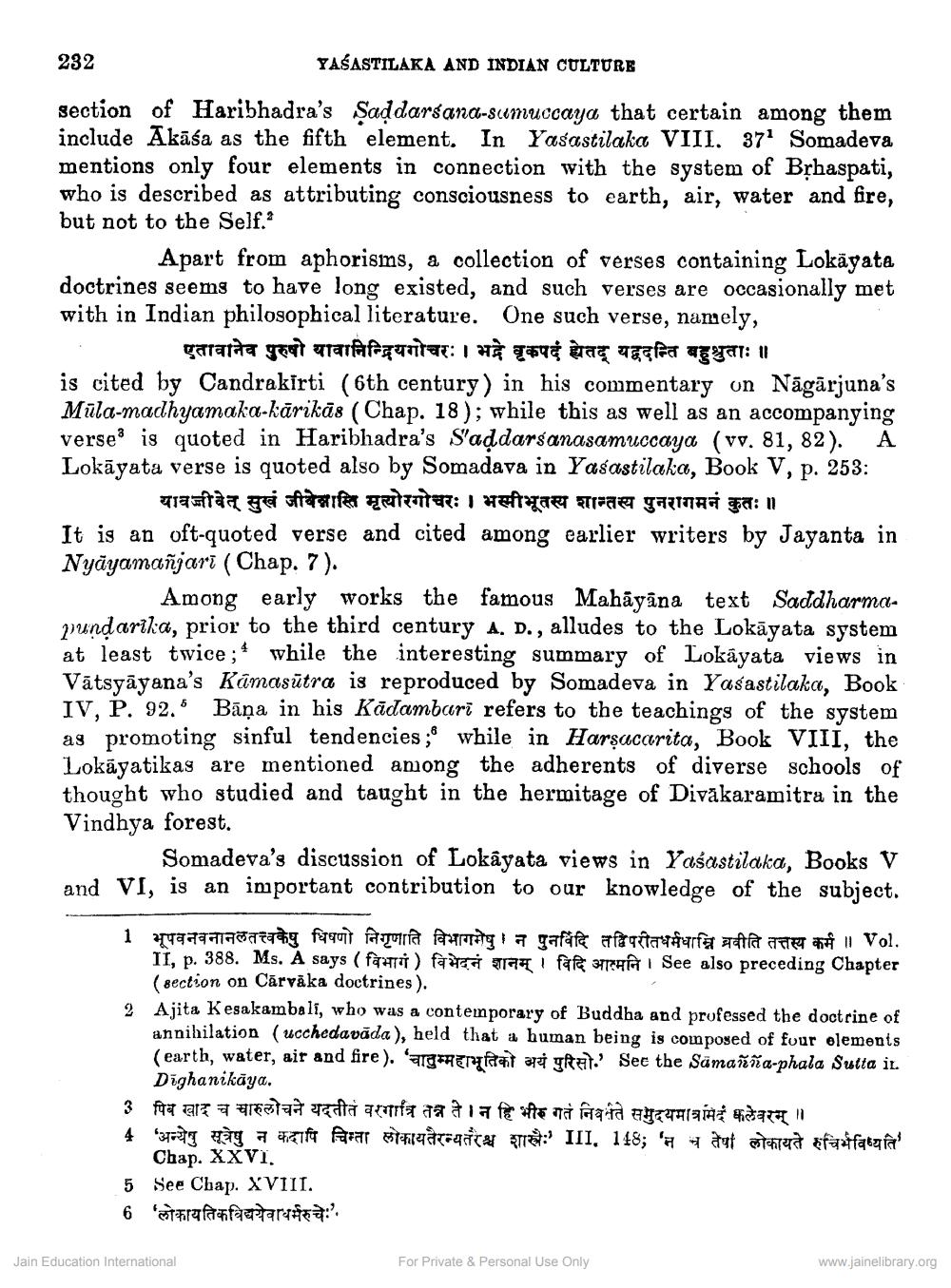________________
232
YAŠASTILAKA AND INDIAN CULTURE
section of Haribhadra's Saddarsana-sumuccaya that certain among them include Akāśa as the fifth element. In Yasastilaka VIII. 37' Somadeva mentions only four elements in connection with the system of Bphaspati, who is described as attributing consciousness to earth, air, water and fire, but not to the Self.
Apart from aphorisms, a collection of verses containing Lokäyata doctrines seems to have long existed, and such verses are occasionally met with in Indian philosophical literature. One such verse, namely,
एतावानेव पुरुषो यावानिन्द्रियगोचरः । भद्रे वृकपदं ह्येतद् यद्वदन्ति बहुश्रुताः ॥ is cited by Candrakirti (6th century) in his commentary on Nāgārjuna's Müla-madhyamaka-kārikās (Chap. 18); while this as well as an accompanying verse is quoted in Haribhadra's S'addarsanasamuccaya (vv. 81, 82). A Lokāyata verse is quoted also by Somadava in Yasastilaka, Book V, p. 253:
यावजीवेत् सुखं जीवेनास्ति मृत्योरगोचरः । भस्मीभूतस्य शान्तस्य पुनरागमनं कुतः॥ It is an oft-quoted verse and cited among earlier writers by Jayanta in Nyāyamañjart (Chap. 7).
Among early works the famous Mahāyāna text Saddharmapundarika, prior to the third century A. D., alludes to the Lokāyata system at least twice ;4 while the interesting summary of Lokayata views in Vātsyāyana's Kamasutra is reproduced by Somadeva in Yasastilaka, Book IV. P. 92.5 Bāna in his Kādambari refers to the teachings of the system as promoting sinful tendencies; while in Harşacarita, Book VIII, the Lokāyatikas are mentioned among the adherents of diverse schools of thought who studied and taught in the hermitage of Divakaramitra in the Vindhya forest.
Somadeva's discussion of Lokāyata views in Yaśastilaka, Books V and VI, is an important contribution to our knowledge of the subject.
1 भूपवनवनानलतत्त्वकेषु धिषणो निगृणाति विभागमेषु । न पुनर्विदि तद्विपरीतधर्मधानि ब्रवीति तत्तस्य कर्म ॥ Vol.
II, p. 388. Ms. A says ( fahri) fa 19 i fare HQ See also preceding Chapter
(section on Cárvāka doctrines). 2 Ajita Kesakambali, who was a contemporary of Buddha and professed the doctrine of
annihilation (ucchedavāda), held that a human being is composed of four elements (earth, water, air and fire). 'arg'ayrat ap that.' See the Samañña-phala Sutta it.
Dīghanikāya. 3 पिब खाद च चारुलोचने यदतीत वरगात्रि तत्र तेन हि भीरु गतं निवर्तते समुदयमात्रमिदं कलेवरम् ॥ 4 3731 T 4ft prar lateral :III, 148; '
H atut ostetud safatafa' Chap. XXVI. 5 See Chap. XVIII. 6 taraffertariaa:'.
Jain Education International
For Private & Personal Use Only
www.jainelibrary.org




